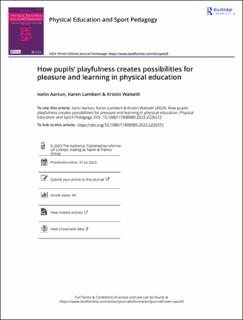| dc.description.abstract | Background: Physical education has been described as too instrumental
and uncritical, where a focus on utility has limited the value of pleasure
in movement. Decades of previous research has addressed the need for
changes where embodied experiences and learning are emphasized
[Kirk, David, and Richard Tinning. 1994. “Embodied Self-Identity,
Healthy Lifestyles and School Physical Education.” Sociology of Health
and Illness 16 (5): 600–625; Kirk, David. 2010. Physical Education
Futures. London: Routledge; Wrench, Alison, and Robyne Garrett. 2015.
“PE: It’s Just Me: Physically Active and Healthy Teacher Bodies.”
International Journal of Qualitative Studies in Education (QSE) 28 (1):
72–91; Wright, Jan. 2000. “Bodies, Meanings and Movement: A
Comparison of the Language of a Physical Education Lesson and a
Feldenkrais Movement Class.” Sport, Education & Society 5 (1): 35–49].
Accordingly, we align with the ongoing call for a ‘corporeal turn’
[Smith, Stephen J. 2007. “The First Rush of Movement: A
Phenomenological Preface to Movement Education.” Phenomenology &
Practice 1 (1): 47–75, 66] in physical education, towards a more
holistic understanding of learning and experience as embodied and
emplaced [Pink, Sarah. 2011. “From Embodiment to Emplacement: Re-
Thinking Competing Bodies, Senses and Spatialities.” Sport, Education
and Society 16 (3):343–355.]. This turn may involve a curriculum where
pleasurable and meaningful movement experiences are educational
goals. Building on this, we ask whether a pedagogy that gives room
for playfulness may be a starting point for physical education being
perceived as more meaningful and pleasurable. Our theoretical
framework builds upon Wellard’s model of body-reflexive pleasure,
Hyland’s understanding of playfulness as a responsive openness and
Gibson’s theories of affordances.
Purpose: In this study we explore pupils’ embodied experiences in
physical education, using empirical findings from a sensory
ethnography. The research questions asked are ‘How do pupils’
playfulness create possibilities for pleasure in physical education? And
which opportunities for embodied learning are being offered through
playful and pleasurable experiences?’ Our aim is to inform and
develop pedagogies of embodiment by including playfulness as a
strategy for facilitating opportunities for pleasurable and meaningful
experiences that enable embodied learning.
Method: The empirical data is based on a sensory ethnographic
fieldwork conducted in a 10th grade class (23 pupils, age 15–16 years)
in Oslo, Norway. The first author conducted the fieldwork as a
participant observer. This included joining all physical education
lessons for one semester and conducting 17 interviews with pupils by
the end of the semester. In the analysis and interpretation process we
have combined ‘the ethnographic hunch’ [Pink, Sarah. 2021. “The
Ethnographic Hunch.” Experimenting with Ethnography: A Companion
to Analysis: 30–40] with an abductive analysis approach [Tavory, Iddo,
and Stefan Timmermans. 2014. Abductive Analysis: Theorizing
Qualitative Research. Chicago and London: University of Chicago Press].
Results and discussion: The findings are represented in three episodes
that show how pupils playfully changed the teacher-given tasks, and in
doing so created possibilities for pleasurable experiences. The findings
are discussed using [Wellard 2012. “Body-reflexive Pleasures: Exploring
Bodily Experiences Within the Context of Sport and Physical Activity.”
Sport, Education and Society 17 (1): 21–33] model of body-reflexive
pleasures and phenomenological perspectives on playfulness [Hyland,
D. 1977. ““And That Is The Best Part of Us:” Human Being and Play.”
Journal of the Philosophy of Sport 4 (1):36–49], and affordances [Gibson,
James J. 1986. The Ecological Approach to Visual Perception. Hillsdale, NJ:
Lawrence Erlbaum Associates]. Playfulness emerged as a criterium for
perceiving activities as pleasurable. The pupils’ playful stance assisted
them in their search for meaning and pleasurable activities because it
enabled them to be open and responsive to the possibilities that
emerged in the physical and social environment. This led to pleasurable
experiences of physical thrill and psychological flow in social interaction
when moving with others. We discuss how pleasurable experiences may
have potential for the pupils’ embodied and emplaced learning, as
participants in place-events. As illustrated in the three episodes, the
playful and pleasurable activities offer opportunities for learning and
practicing integrated competencies, e.g. physical, social, and creative
competencies. Suggested implications for physical education teachers
may involve giving pupils the freedom to be playful by being open to
letting pupils’ innovative initiatives influence the teaching and
contribute to create a safe space for movement exploration. | en_US |

